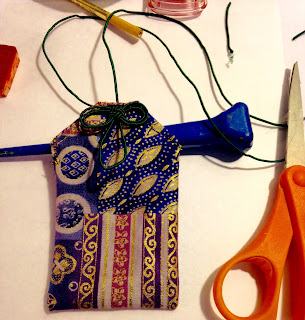Kakizome is a way to express your positive wishes for the New Year.
Agenda:
1. Practice my calligraphy
2. Make an omamori
1. Practice my calligraphy:
In Japan, calligraphy is part of the curriculum in all schools. On Kakizome Day, students begin the year by practicing their calligraphy skills.
These pictures are from a few year's ago, when my art students got a chance to practice Japanese calligraphy.
You don't have to write in Japanese if that's intimidating.
Supplies: Ink stone, ink stick, sumi brush, newsprint, rice paper
2- Grind your own ink (optional): Ink grinding gives you a meditative moment to reflect your thoughts and wishes for the new beginning of the year. Just add a few drops of water to the ink stone and slide the ink stick back and forth until a small amount of ink forms in the well.
 3- Practice with the brush and ink: Japanese calligraphy requires skill- you have to hold the brush just so, and stroke and place the characters on the paper with precision and beauty. Try out the calligraphy on newsprint several times to get the feel for it before you use the rice paper. Practicing one positive kanji over and over helps you to develop skill and also focus on the positive theme you have selected.
3- Practice with the brush and ink: Japanese calligraphy requires skill- you have to hold the brush just so, and stroke and place the characters on the paper with precision and beauty. Try out the calligraphy on newsprint several times to get the feel for it before you use the rice paper. Practicing one positive kanji over and over helps you to develop skill and also focus on the positive theme you have selected.4- If you end up with something you like, you can mount it on heavier paper and hang it to give you inspiration all year. Or you can make it small enough to fit inside your omamori.
 |
| Omamori from 2017 |
2. Make an Omamori:
Starting at dawn on New Year’s Day, Japanese people flock to shrines and temples to offer prayers and wishes for the New Year. While there, each person buys a new omamori- a traditional Japanese cloth charm- and returns last year’s omamori to be burned.
Omamori is Japanese for “honorable protector”. They are most commonly rectangular, and contain a piece of wood or paper inside, with some powerful Shinto or Buddhist words for protection, or health, or luck, or a variety of other specific uses. The cool thing about omamori is that they are personal and portable. You can carry your omamori however feels right to you: It’s common to attach a safety omamori to a backpack to protect a child on the walk to school, or to keep a study omamori in a pencil case, or hold it in a pocket during an exam.
Since I can't buy an omamori at a local temple, I decided to make my own a couple of years ago, for trafic safety.
Supplies: sturdy fabric, paper for the pattern, scissors, needles and thread, awl (or something else pointing), cord, nice paper for the writing, pen or sumi ink and brush
1- Draw and cut a pattern: Mine is 2-1/2 by 4-inches. Omamori are usually rectangular with angles at the top.
2- Fold your fabric in half at the bottom edge of the pattern and cut.
3- Turn the fabric inside out (front to front) and sew up the sides, but not the angled top. (The bottom is the fold line.) You can sew by hand or on a machine.
4- Turn the fabric right sides out again and poke out all the corners.
5- Now you are ready to write your sacred words. Omamori can have a general blessing and protection or it can have specific focus such as:
Kaiun (good luck) 開運
Katsumori (success) 勝守
Koutsuu-anzen (traffic safety) 交通安全
Gakugyou-joujo (education and passing tests) 学業乗除
Gakugyou-joujo (education and passing tests) 学業乗除
Shiawase (happiness) 幸せ
Enmusubi (love) 縁結び


I'm not sure what words are usually inside an omamori, so I just wrote the words of the purpose, which was traffic safety.
6- Once you write out your words, slide them inside. (I put mine in plastic first to protect from rain).
Then finish sewing up the angled edges and the top to totally encase your wish.
7- Omamori are hung by a cord tied with a special Japanese tassel knot. I found this great video tutorial showing how to tie it.

8- Once your knot it tied, poke a hole in the top of your omamori with an awl or something else that's poky.
 |
| Front |
 |
| Back |
My omamori has been on my bike handlebars for three year's now, flapping around as I ride through all weather. It's still in great shape so I decided to let it work for another year.








No comments:
Post a Comment